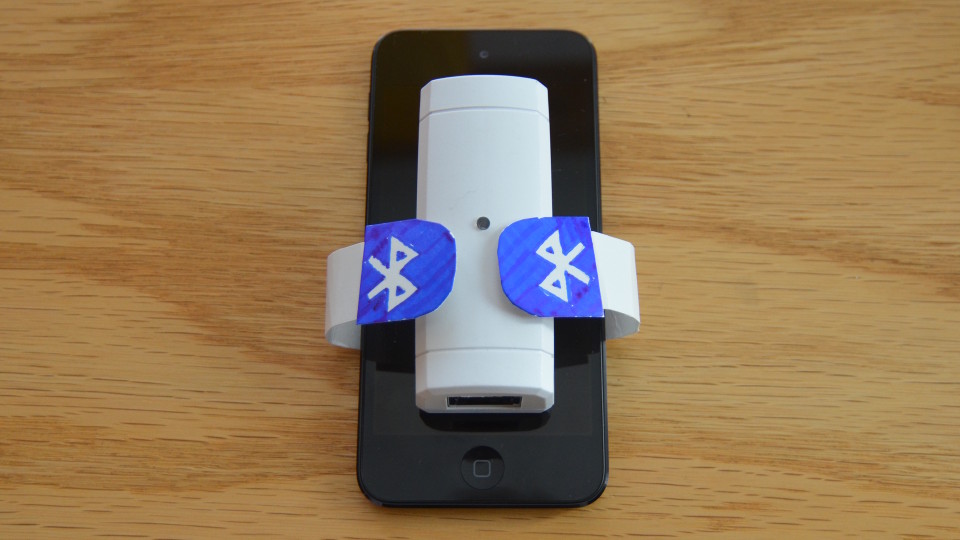We are very pleased to announce the successful integration of mobile devices with reelyActive infrastructure using Bluetooth Low Energy (BLE) technology. Watch the video above to see an iPod advertising its presence to our new BLE reelceivers, allowing it to be located and uniquely identified, exactly like our existing active RFID tags.
This means that any device with BLE hardware and, critically, the software support to send unsolicited advertising packets, can integrate seamlessly with the reelyActive platform and participate in the Log in to Life experience [EDIT: rebranded as smartspac.es as of 2014]. No longer will a reelyActive tag be required, the smartphone in your pocket will soon take its place. Taking advantage of a reelyActive-enabled space will require no more than running an application in the background.
This demonstration has been a long time in the making. One year ago, Nokia announced the launch of the In-Location Alliance with 22 industry partners, touting BLE as an essential ingredient. However, only last week did we see major indoor location announcements by Estimote and PayPal. The reason is simple: while BLE hardware has been around since the iPhone 4S and Galaxy S3, full OS-support is only just emerging. This summer’s release of Android 4.3 brings partial BLE support, but does not yet implement the functionality we require. However, soon-to-be-released iOS7 embraces BLE and is the first mobile OS to support the unsolicited advertising functionality our platform requires. And, fortunately, the Texas Instruments chip we selected for our reelceiver is versatile enough to support these (arguably) non-standard packets. As we learned from attending the Bluetooth SIG working group in Montreal last week, the establishment of standards among competing vendors is far from an elegant process!
Earlier this year we blogged about the two approaches to radio location. For the reasons cited, we have taken the opposite approach to the companies building beacons, which further include Tod and Tile. Nonetheless, our hardware can implement both approaches simultaneously. In other words, each BLE reelceiver can advertise its own geolocation to mobile devices in range, making them location-aware. At the same time, the reelceiver listens for devices in range which advertise their presence and identity, relaying that information with either the cloud or a local server. It’s the best of both worlds. And, since our reelceivers have perpetual power and network-connectivity, they have the advantage of requiring no maintenance and supporting real-time updates, unlike many of the aforementioned beacons.
Next month we will present a live demo at the 38th IEEE Conference on
Local Computer Networks (LCN) in Sydney, Australia in conjunction with the scientific article we are presenting on the subject as part of M2MCIP 2013. The reel architecture has proven its versatility by simultaneously supporting heterogeneous radio communication protocols and providing plug-and-play extension of coverage. While we’re excited about the future applications for smartphones, they are nonetheless only a subset of all the devices which support BLE. Many of the billions of low-power wireless devices that will make up the Internet of Things will employ BLE technology, and our reels will be ready to provide them with the low-power ambient connectivity they require.

Comments
10 responses to “Beyond the Beacon: BLE Just got Reel”
[…] company details the trick on its blog and in the video […]
LikeLike
[…] LE: ReelyActive have an interesting blog post about working with BLE (Bluetooth Low Energy) and how they use it in-building location and how, […]
LikeLike
[…] As previously announced, the iOS7 that becomes available Sept. 20 includes functionality that enables communication with Bluetooth Low Energy (BLE) systems, utilizing the new Bluetooth 4.0 chip. With this comes a new approach to in-store location-specific smartphone communications, like offering opt-in users coupons relevant to their location in the store. iBeacon sensors (called ‘motes’) are already available from vendors like Roximity and Estimote, and Canadian tech start-up ReelyActive has found a way to make the communication work in reverse, according to their blog and video. […]
LikeLike
[…] our last blog post, Beyond the Beacon: BLE Just Got Reel, we demonstrated an iOS7 device advertising its presence to our hardware infrastructure using […]
LikeLike
[…] As previously announced, the iOS7 that became available Sept. 20 includes functionality that enables communication with Bluetooth Low Energy (BLE) systems, utilizing the new Bluetooth 4.0 chip. With this comes a new approach to in-store location-specific smartphone communications, like offering opt-in users coupons relevant to their location in the store. iBeacon sensors (called ‘motes’) are already available from vendors like Roximity and Estimote, and Canadian tech start-up ReelyActive has found a way to make the communication work in reverse, according to their blog and video. […]
LikeLike
[…] awareness. When everyone and everything in proximity can be uniquely identified by their wearables (including smart phones), and each is associated with its corresponding digital footprint and/or personal preferences, you […]
LikeLike
[…] over a year ago we published a blog post entitled “Beyond the Beacon: BLE Just Got Reel where we showed how our technology could detect and identify iOS7 devices using Bluetooth Smart […]
LikeLike
[…] wrong on the timeline. 2013? Ha! Apple wouldn’t unveil iBeacon until the Fall of that year (which we totally capitalised on). Nonetheless, we were very un-wrong in our prediction: there are currently 3 billion Bluetooth […]
LikeLike
[…] years ago today on this blog, we published Beyond the Beacon: BLE just got Reel. In honour of that anniversary, today we publish Three years Beyond the Beacon: the Physical Web […]
LikeLike
[…] our own infrastructure has been listening since 2013. We’ve learned a lot since then, patiently waiting for a brilliant solution to the pervasive […]
LikeLike